When it comes to giving your garden a spring-ready refresh, there’s no color as bold and bright as blue. Add excitement to your landscape with clusters of lavender blue, electric cobalt, and deep indigo blossoms. There are so many choices beyond your favorite bold blue hydrangeas to fill up your flowerbeds, porch containers, hanging baskets, or curbside plots with blue flowering plants. So head to the garden shop, walk right past those azaleas, and go for the blue. These 25 blue flowers will have your garden looking more gorgeous than ever.
Balloon Flower
- Botanical Name: Platycodon grandifloras
- Sun Exposure: Full sun, part shade
- Soil Type: Well-drained, moist, organically rich
- Soil pH: Slightly acidic to neutral
This show-stopping perennial gets its name from flower buds that inflate like balloons before they pop open to reveal star-shaped blooms. Make sure to remove spent blooms, and this plant will keep producing fresh flowers from early to late summer. Depending on the variety, balloon flowers can grow from 6 inches to 2 feet tall—’Astra Blue,» «Hakone Blue,» and «Fuji Blue» are some of the bluest.
Blue Phlox

- Botanical Name: Phlox divaricata
- Sun Exposure: Part shade, shade
- Soil Type: Moist, rich, can tolerate clay
- Soil pH: Mildly acidic to neutral
You can’t help but be in a good mood when these springtime flowers sweep over your flowerbed floor. Also known as woodland phlox, this native groundcover bears open clusters of powder-blue or lavender-blue and can grow from 8 to 18 inches tall. The sweetly fragrant flowers will attract butterflies, moths, and bees in your woodland garden. Can tolerate dry spells once established.
Blue Catmint

- Botanical Name: Nepeta x faassenii
- Sun Exposure: Full sun, part shade
- Soil Type: Any well-drained soil, rocky soil
- Soil pH: Acidic, neutral
Months of blooming, drought-tolerant, highly aromatic, and your cat will love you for it—what’s not to like? Flowers range from lavender-blue to a deeper blue-purple. Plant it near a path or in your rock garden, shearing on occasion to encourage more flowers.
Clematis
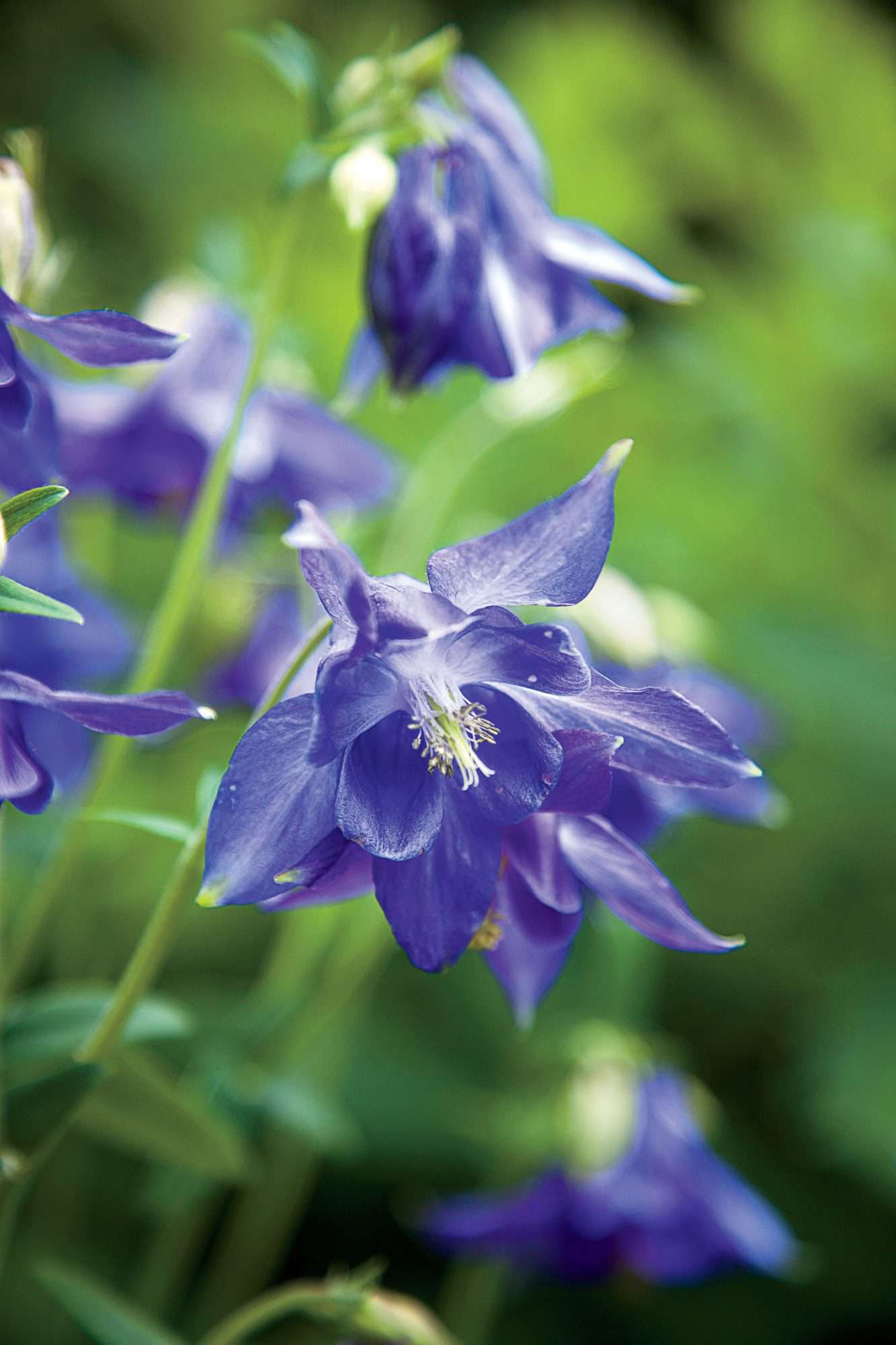
- Botanical Name: Clematis spp.
- Sun Exposure: Full sun
- Soil Type: Well-drained, rich
- Soil pH: Slightly acidic, neutral
Clematis» big blooms charm us whether they are scrambling up a mailbox, blanketing a trellis, or traveling along a fence. There are many types of clematis, with the showiest hybrids usually preferring full sun on their leaves and shade on their roots (provided by mulch or low-growing plants). While purple blooms are the most popular, there are sky blue, indigo blue, and powder blue selections.
Cornflower (Bachelor’s Button)

- Botanical Name: Centaurea cyanus
- Sun Exposure: Full sun
- Soil Type: Well-drained, average moisture
- Soil pH: Mildly acidic to alkaline
The blossoms of this annual will fit into any cozy cottage garden and easily naturalize around meadows and farms. Get the double flowers for a dramatic pop of pigment. In fact, the hue is so eye-catching that you’ll catch it in boutonnieres come prom season. «Tall Blue» and «Blue Boy» grow to 3 feet, while «Dwarf Blue Midget» tops out at 1 foot tall.
Delphinium
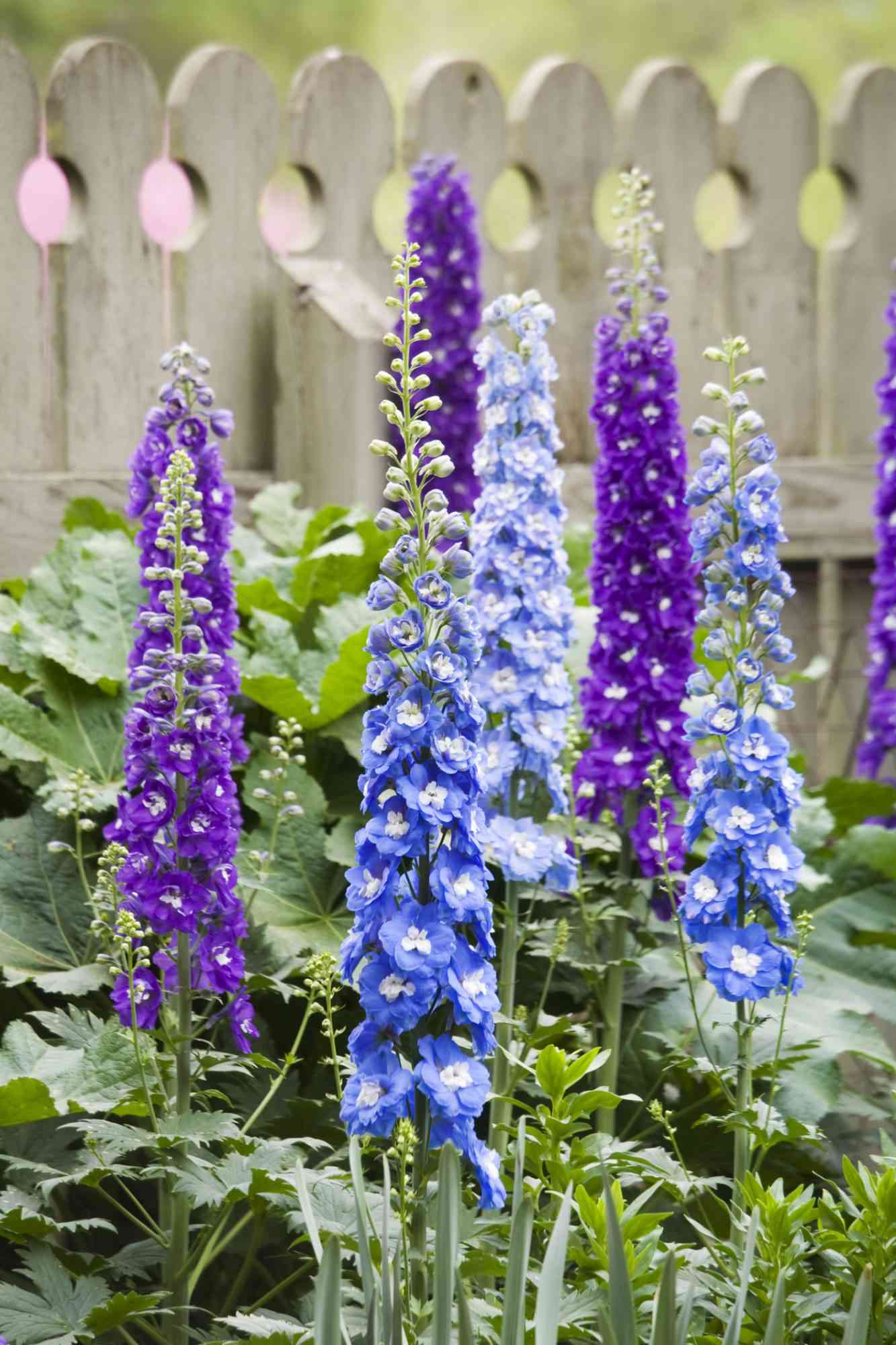
- Botanical Name: Delphinium spp.
- Sun Exposure: Full sun, afternoon shade
- Soil Type: Rich, well-drained
- Soil pH: Neutral to slightly alkaline
Yes, you too can grow this romantic cottage garden flower—native species like Carolina larkspur (D. carolinianum) and tall larkspur (D. exaltatum) are more reliable in the South. Plant delphiniums at the back of your sunny border in rich soil and water regularly. Staking and fertilizing will help you to achieve stunningly tall spikes of blue and purple flowers.
Eastern Bluestar
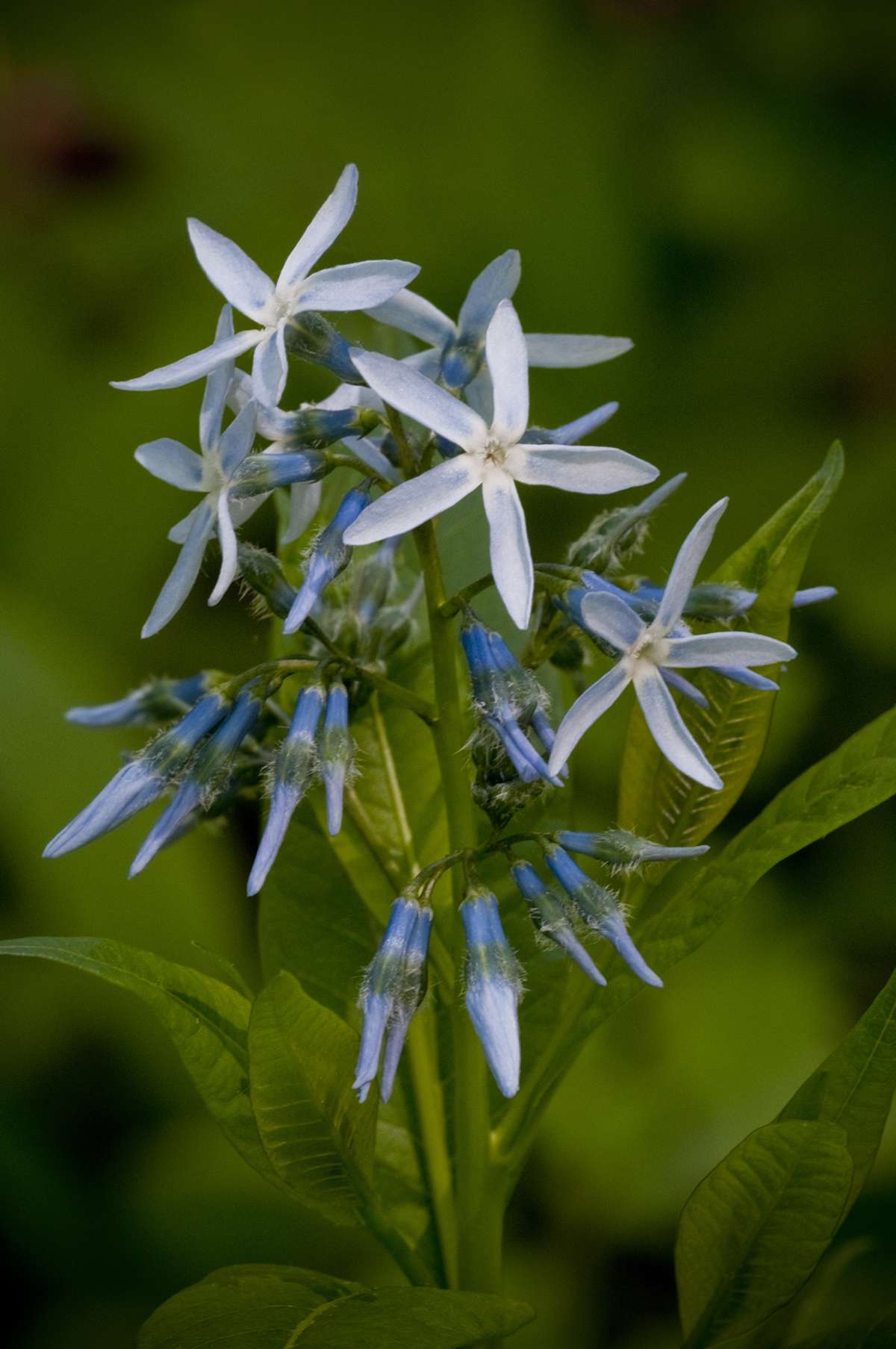
- Botanical Name: Amsonia tabernaemontana
- Sun Exposure: Full sun, part shade
- Soil Type: Sandy, loamy, moist
- Soil pH: Neutral
This 2-to-3-foot perennial is covered with powder blue flowers in spring, while its leaves turn a brilliant yellow in fall. Plant this native in a rain garden or in drifts along a flower border to attract hummingbirds, bees, and butterflies. Eastern bluestar adapts to most soils and can tolerate dryness once established.
Edging Lobelia
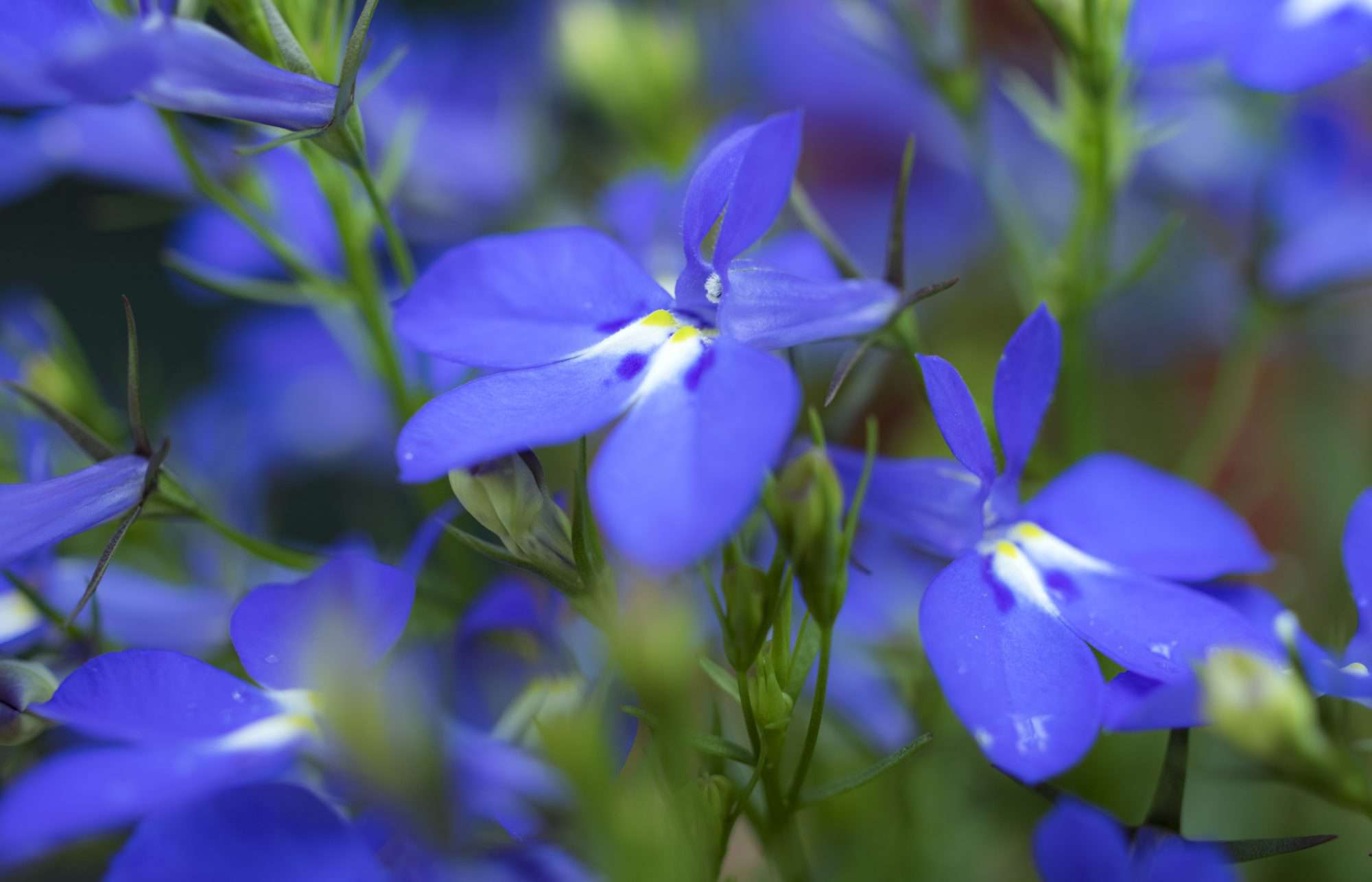
- Botanical Name: Lobelia erinus
- Sun Exposure: Full sun, part shade
- Soil Type: Organically rich, moist, well-drained
- Soil pH: Slightly acidic to neutral
This tubular, lipped flower is so electric blue you won’t be able to pull your eyes away. Grow it as a winter-to-spring annual, planting to spill over the edge of containers or at the front of your garden where its matlike clumps can’t be missed. Lobelia prefers cool temps and plenty of moisture.
Blue False Indigo
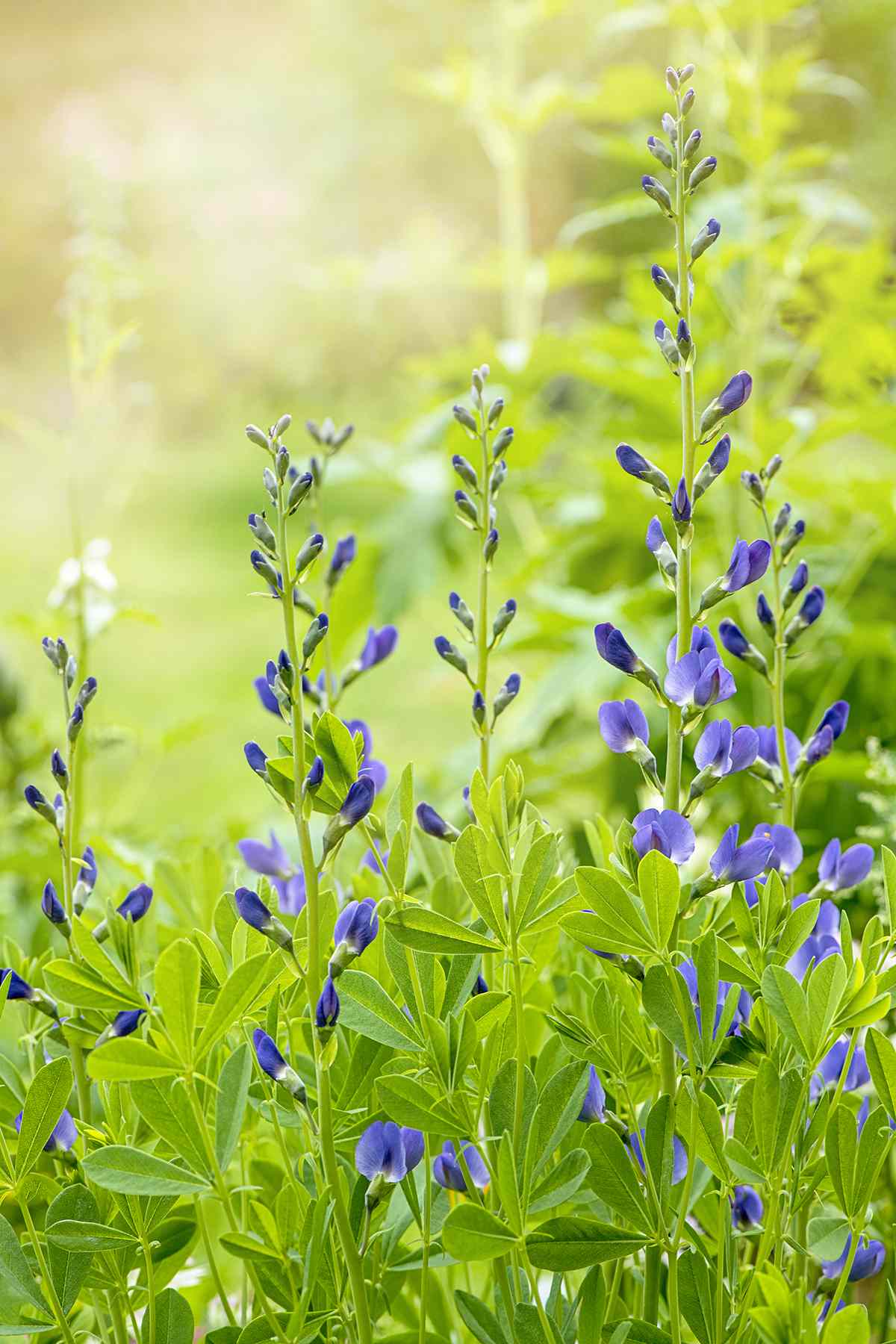
- Botanical Name: Baptisia australis
- Sun Exposure: Full sun
- Soil Type: Well-drained, moist, clay
- Soil pH: Acidic, neutral
False indigo is a native of praries and woodland edges that has become popular for its ability to thrive in poor soil, clay, and hot and humid summers. The plant emerges as a large clump each spring, sending out spikes of sweet-pea like flowers. The flowers later turn to blackened, rattling pods. Find it a good home and leave it there—the tap root makes this tough plant drought-tolerant but hard to transplant.
Fan Flower
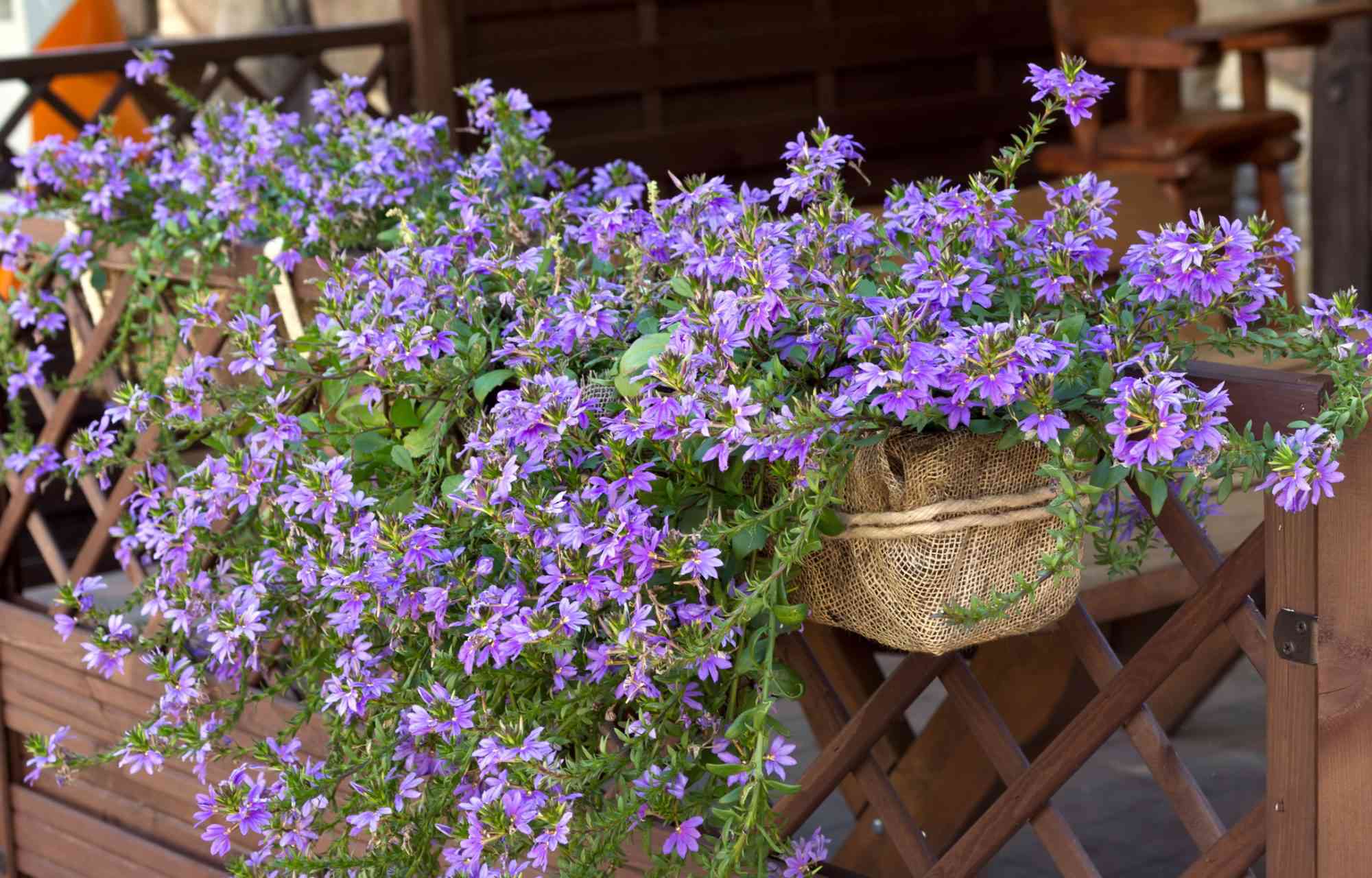
- Botanical Name: Scaevola aemula
- Sun Exposure: Full sun, part shade
- Soil Type: Well-drained
- Soil pH: Acidic, neutral
You’ll know you’ve treaded into dreamy blue-violet waters when you see that this annual flower is also known as the «fairy fan-flower.» No matter which name you prefer, this plant known for its fan-shaped blooms and is heat- and drought-tolerant. Plant it in blues, pinks, and purples in your hanging baskets, window boxes, or flower beds, and allow to dry out slightly between waterings.
French Hydrangeas

- Botanical Name: Hydrangea macrophylla
- Sun Exposure: Morning sun or filtered sunlight all day
- Soil Type: Moist, well-drained
- Soil pH: Acidic for blue color
The beloved French hydrangea takes on a bright sky blue color in acidic soil (neutral soil results in purple flowers and alkaline soil turns them pink). Plant your shrub in a location with morning sun in well-drained soil amended with organic matter. Water when dry and your shrub will be loaded with sky-blue powderpuffs in late spring and summer.
Forget-Me-Nots

- Botanical Name: Myosotis palustris
- Sun Exposure: Full sun, part shade
- Soil Type: Moist
- Soil pH: Mildly acidic to mildly alkaline
They had us at the name. The variety «Southern Blues» tolerates more heat than most, making it a good choice for the South. Forget-Me-Nots do best in part sun or light shade in the hotter parts of the country, thriving in damp spots like along the edge of a pond. This little plant will spread like a ground cover in moist garden soils, filling in the gaps in your garden and blooming from spring into summer.
Globe Thistle
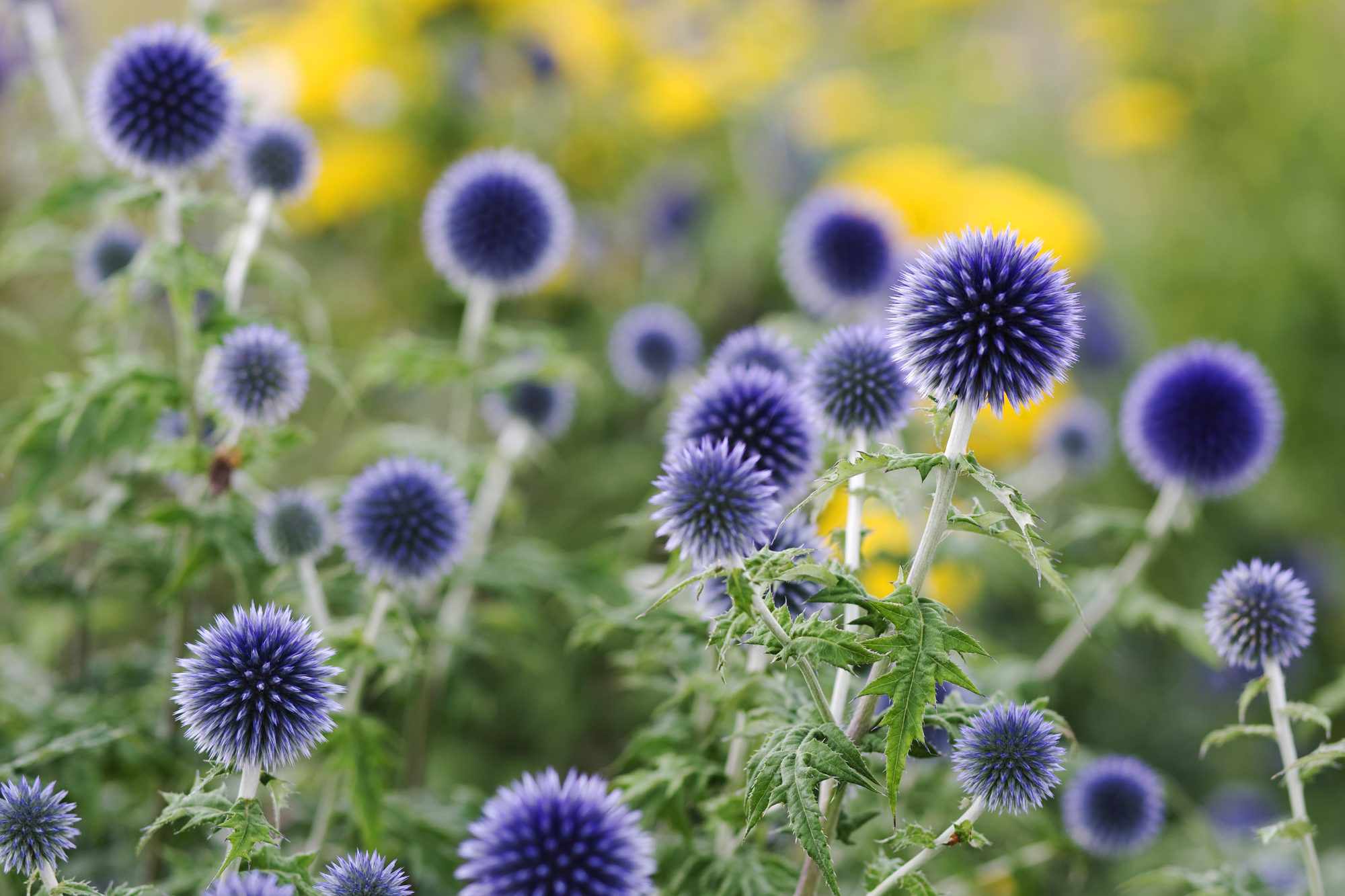
- Botanical Name: Echinops ritro
- Sun Exposure: Full sun
- Soil Type: Well-drained, average
- Soil pH: Acidic, neutral
The spherical, spiny blue blooms of globe thistle are a bee magnet for your garden at a welcome time of year, blooming through late summer into early fall. Plant it in a well-drained soil that isn’t overly fertile. The grayish-green foliage will stand up to drought, rabbits, and deer.
Grape Hyacinth
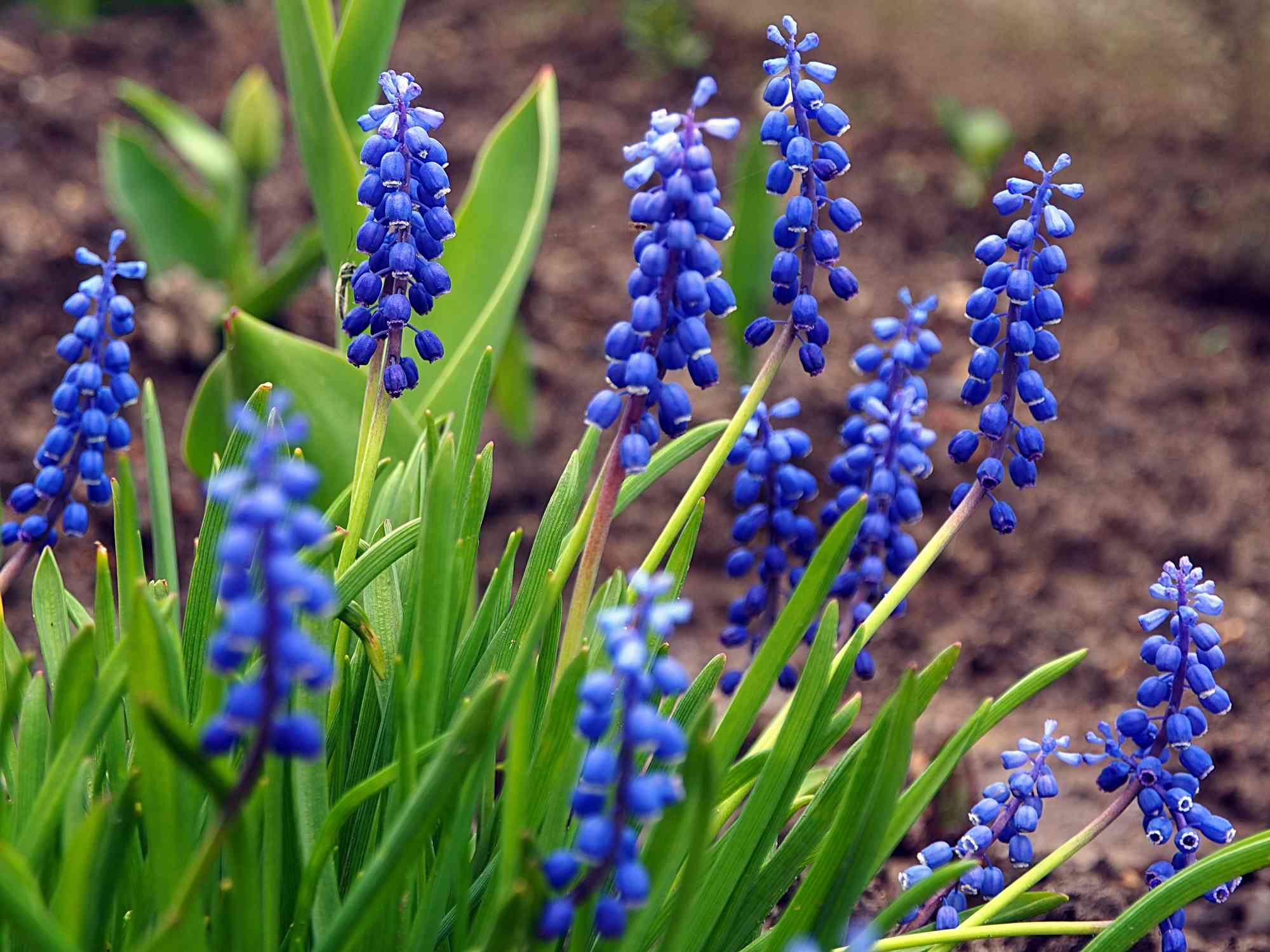
- Botanical Name: Muscari spp.
- Sun Exposure: Full sun, part shade
- Soil Type: Well-drained, rich
- Soil pH: Neutral
The Grumpy Gardener once declared that these flowers are «absolutely the best, most dependable source of true, deep blue in the bulb world.» Plant bulbs in fall for early spring blooms on 4-to-8-inch stems. Grape hyacinth look most glorious in full sun, but can be planted under deciduous trees where the sun reaches in spring, or even grown in a pot.
Iris
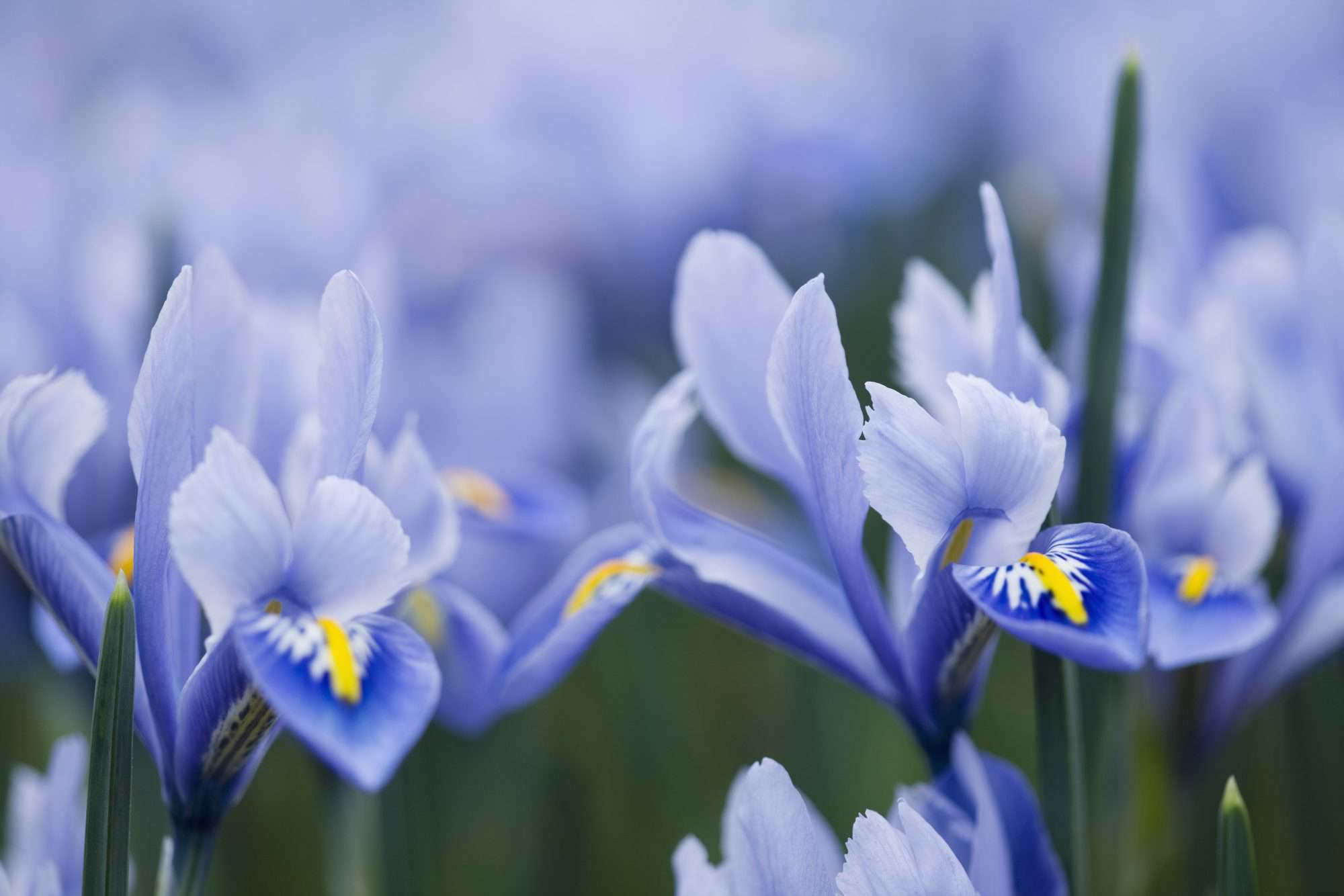
- Botanical Name: Iris spp.
- Sun Exposure: Full sun, part sun
- Soil Type: Moist
- Soil pH: Slightly acidic, neutral
Nowadays irises come in every color of the rainbow, including from the iciest blue to the deepest sapphire. Contrasting stripes of yellow or white add even more drama to these old-fashioned flowers. There are many species of iris, from tiny to tall and from shade-loving to sun-loving. Regardless of which iris you add to your garden, plant it shallowly in a moist spot.
Morning Glory
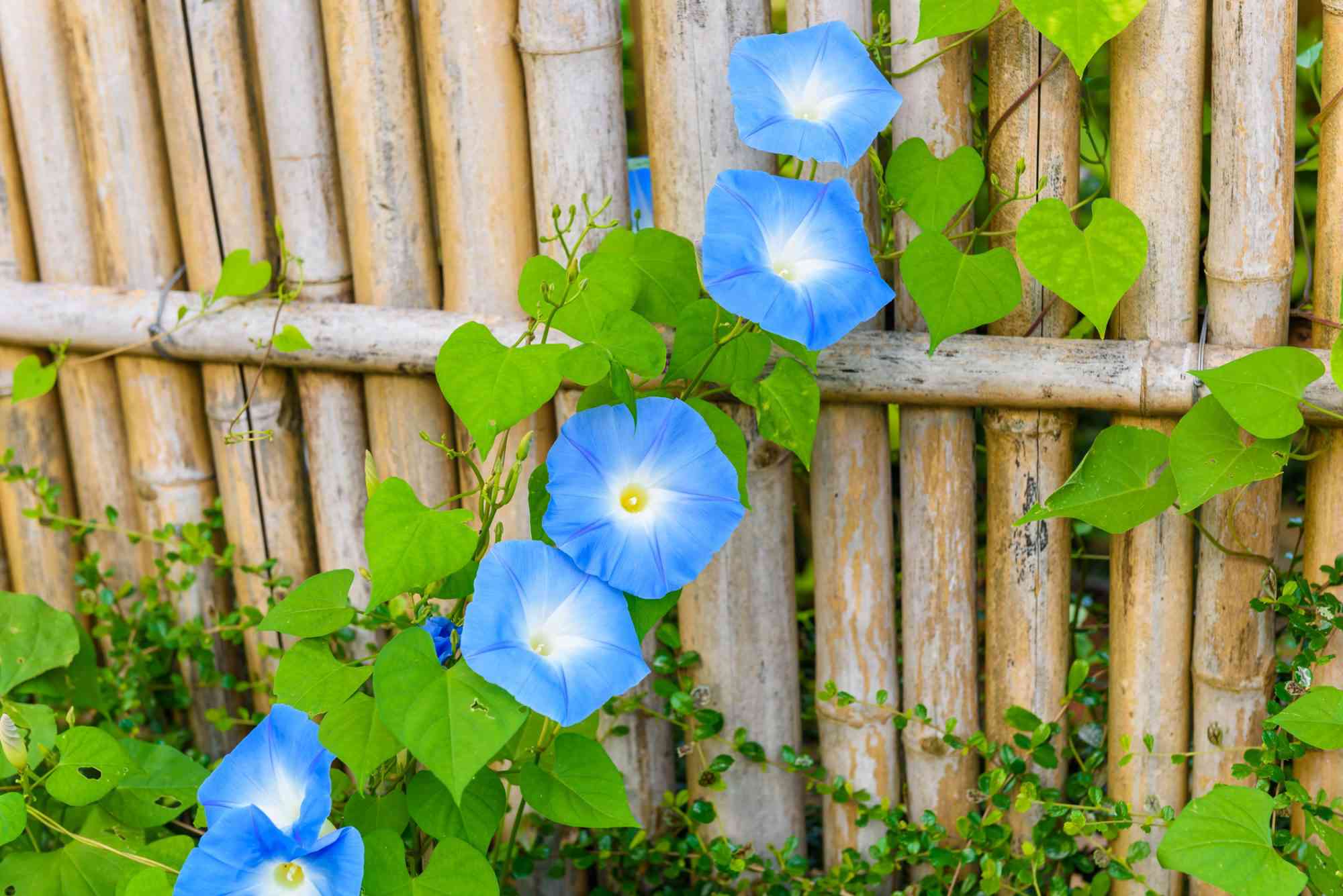
- Botanical Name: Ipomoea tricolor «Heavenly Blue»
- Sun Exposure: Full sun
- Soil Type: Moderately fertile, well-drained
- Soil pH: Slightly acidic to neutral
Sow after the last frost and let these blue-hued annual vines roam wild—up a trellis, in a container, or wherever else in the garden you please. Among a number of blue varieties, morning glory «Heavenly Blue» produces pure sky-blue flowers with yellow throats, making it an eye-catching addition during its blooming period that can last from summer until frost.
Lily of the Nile
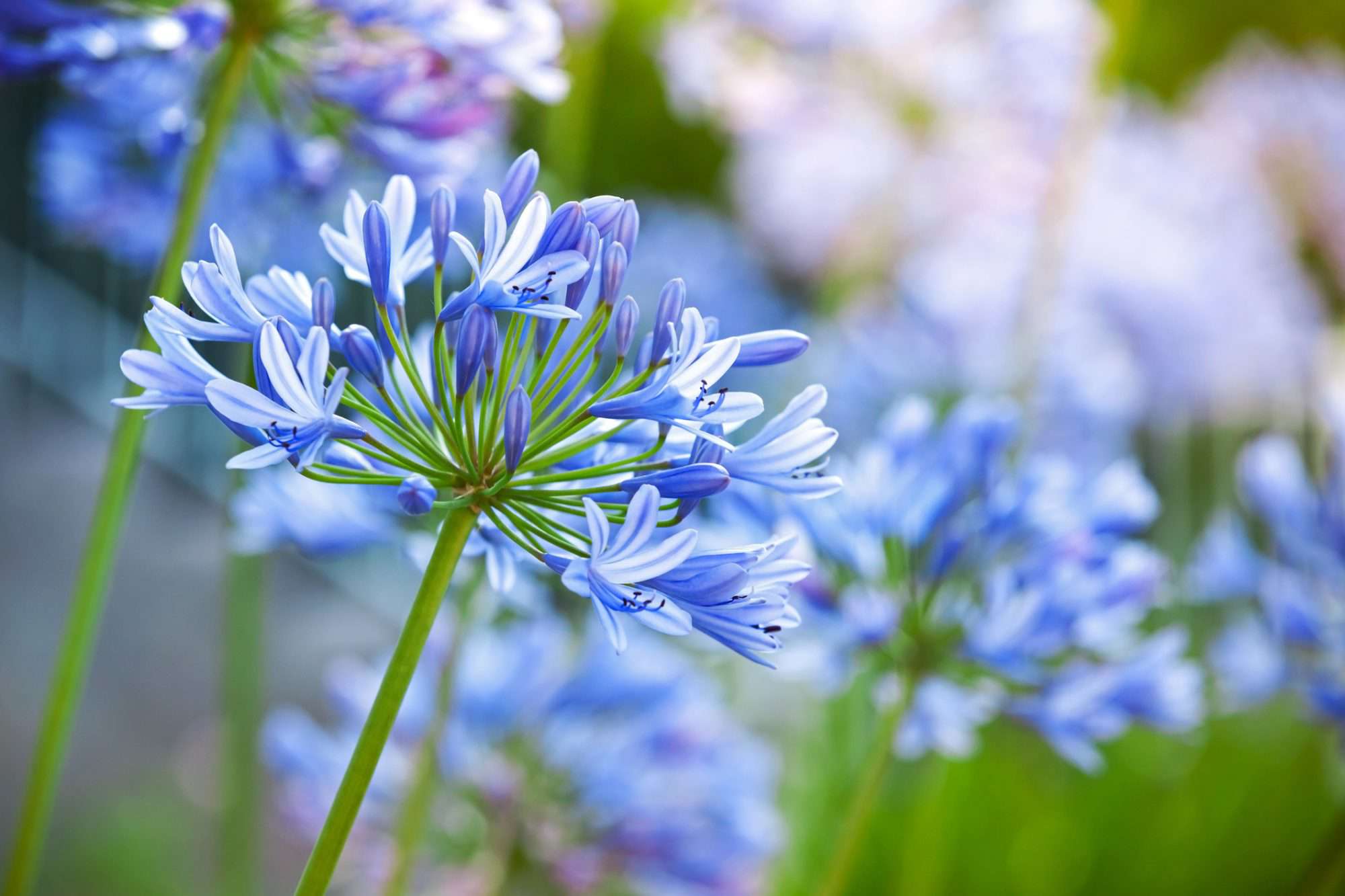
- Botanical Name: Agapanthus africanus or A. umbellatus
- Sun Exposure: Full sun, part shade
- Soil Type: Well-drained with organic matter
- Soil pH: Acidic, neutral
Your garden guests will swoon over these fountainlike clumps of strap-shaped leaves with blooms like little bursts of blue fireworks. Agapanthus is hardy in warmer regions in the South (some varieties are hardier than others, so check the plant label). Try Ever Sapphire™, a tough, drought-tolerant, reblooming variety from the Southern Living Plant Collection. Agapanthus makes a great container plant, where it can be given ideal growing conditions and regular fertilizer.
Lupine

- Botanical Name: Lupine spp.
- Sun Exposure: Full sun, part sun
- Soil Type: Well-drained; sandy or rich soil, depending on species
- Soil pH: Slightly acidic, neutral
There are around 200 species of lupines growing from Maine to the southwest, but the deep blue blooms of Texas bluebonnet (L. havardii) may be the most famous. The Texas state flower, L. subcarnosus, is a smaller plant with sky-blue flowers. According to The New Southern Living Garden Book, «Most lupines take poor soil, but hybrids prefer rich, slightly acidic, well-drained soil.» Plant lupines in full sun or part shade and enjoy their charming, cottagey blooms.
Perennial Geranium «Johnson’s Blue»
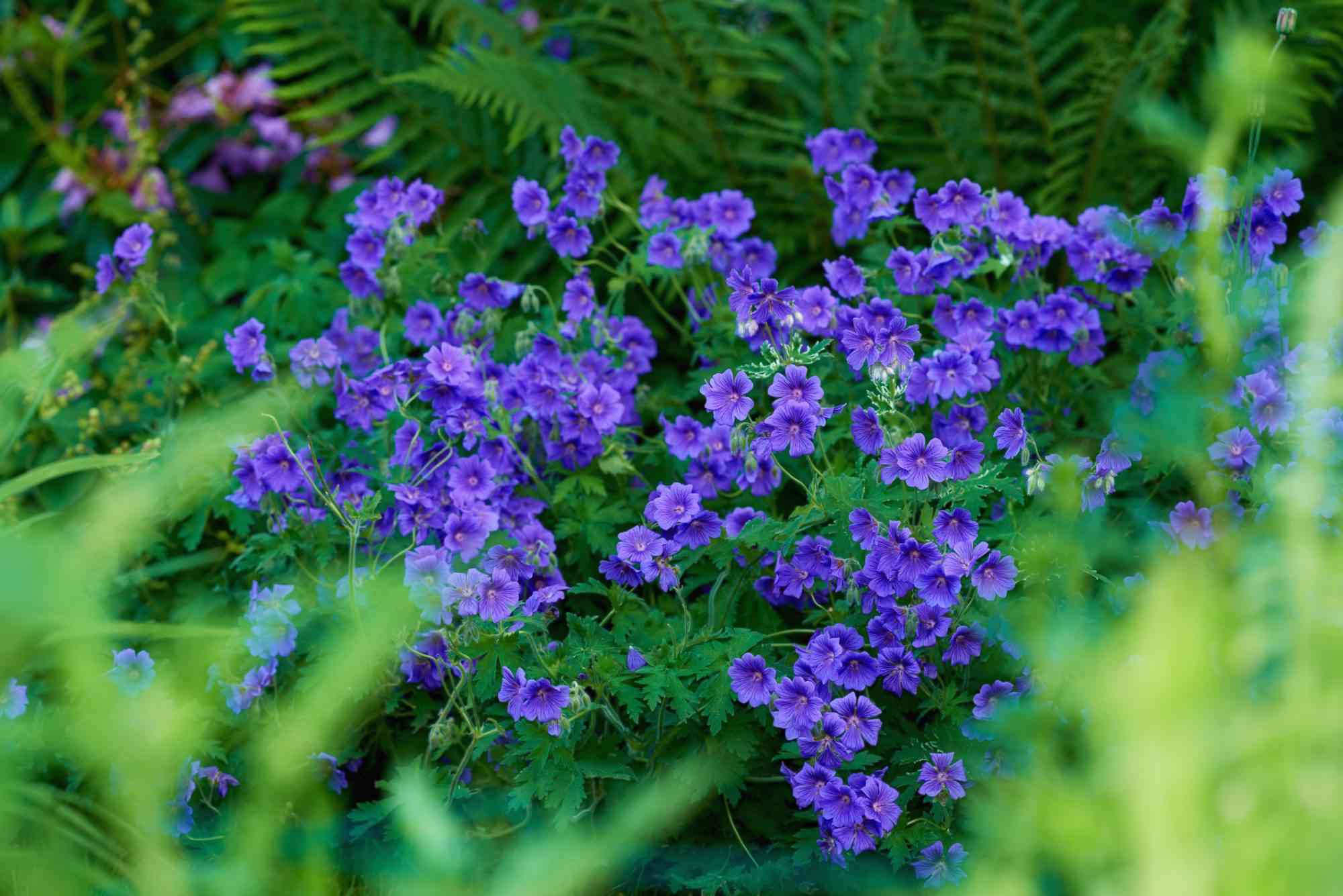
- Botanical Name: Geranium «Johnson’s Blue»
- Sun Exposure: Full sun to part shade
- Soil Type: Well-drained with organic matter
- Soil pH: Acidic, neutral, alkaline
Known as a true blue flower, this fairly care-free geranium hybrid thrives in average soils. Also called cranesbill geranium, this perennial is hardy to USDA Zone 8, drought-resistant and disease-resistant, and attracts butterflies and bees. Plant it at the front of a border and enjoy the blooms for months, giving it a late-summer trim and occasional watering to keep it going.
Petunias
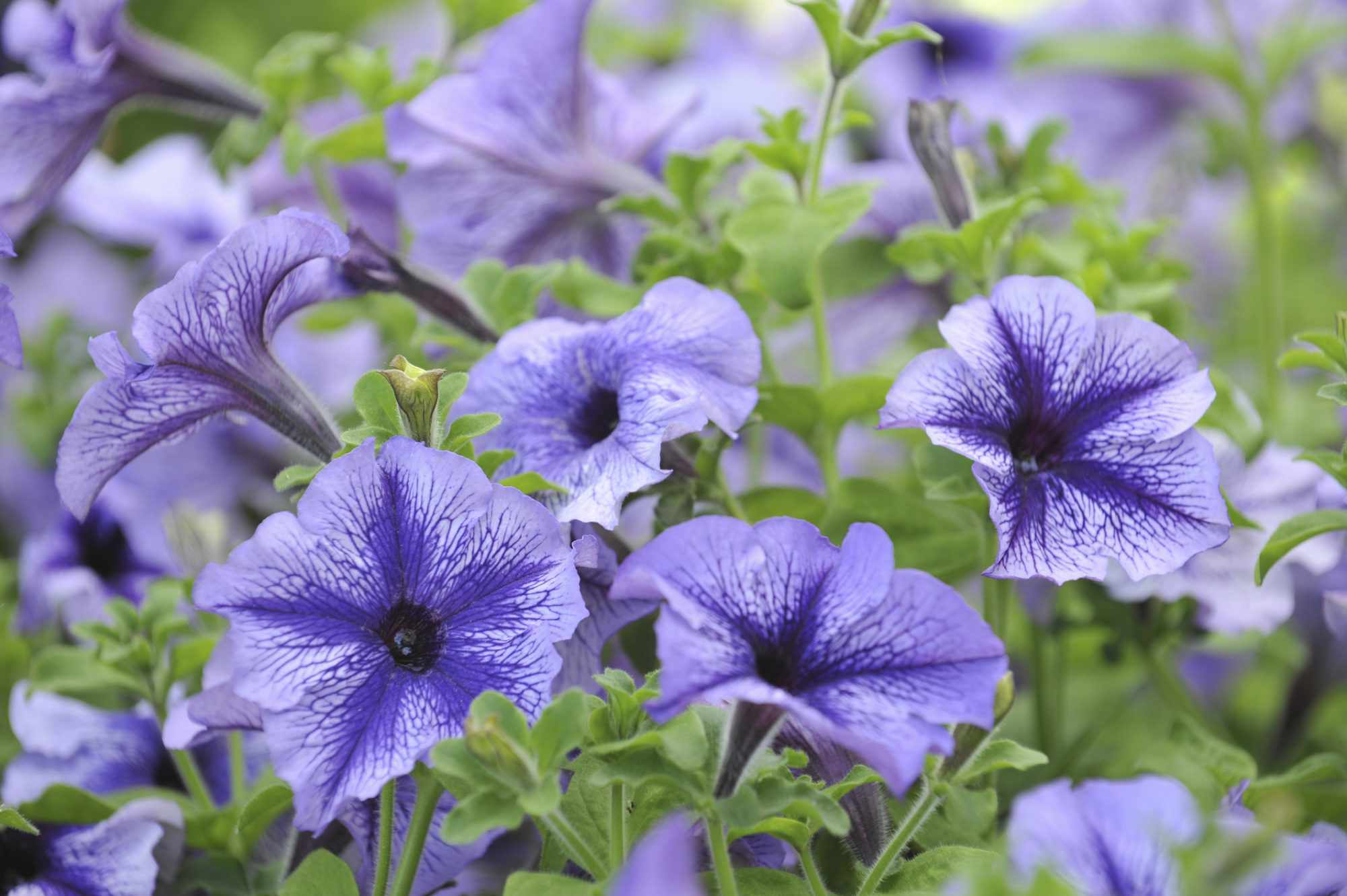
- Botanical Name: Petunia × hybrida
- Sun Exposure: Full sun
- Soil Type: Rich, well-drained, moderately moist
- Soil pH: Mildly acidic to neutral
This classic flower is everywhere, which means you won’t have a hard time finding blue hybrids—like «Wave Blue,» «Supertunia Blue Skies,» and «Surfinia Sky Blue’—that hold up much better to summer heat and humidity than their predecessors. And many selections don’t even require deadheading. Count on these blooms to brighten up your garden until the first frost—cut back leggy growth and fertilize to reinvigorate any plants spent by the summer heat.
Salvia
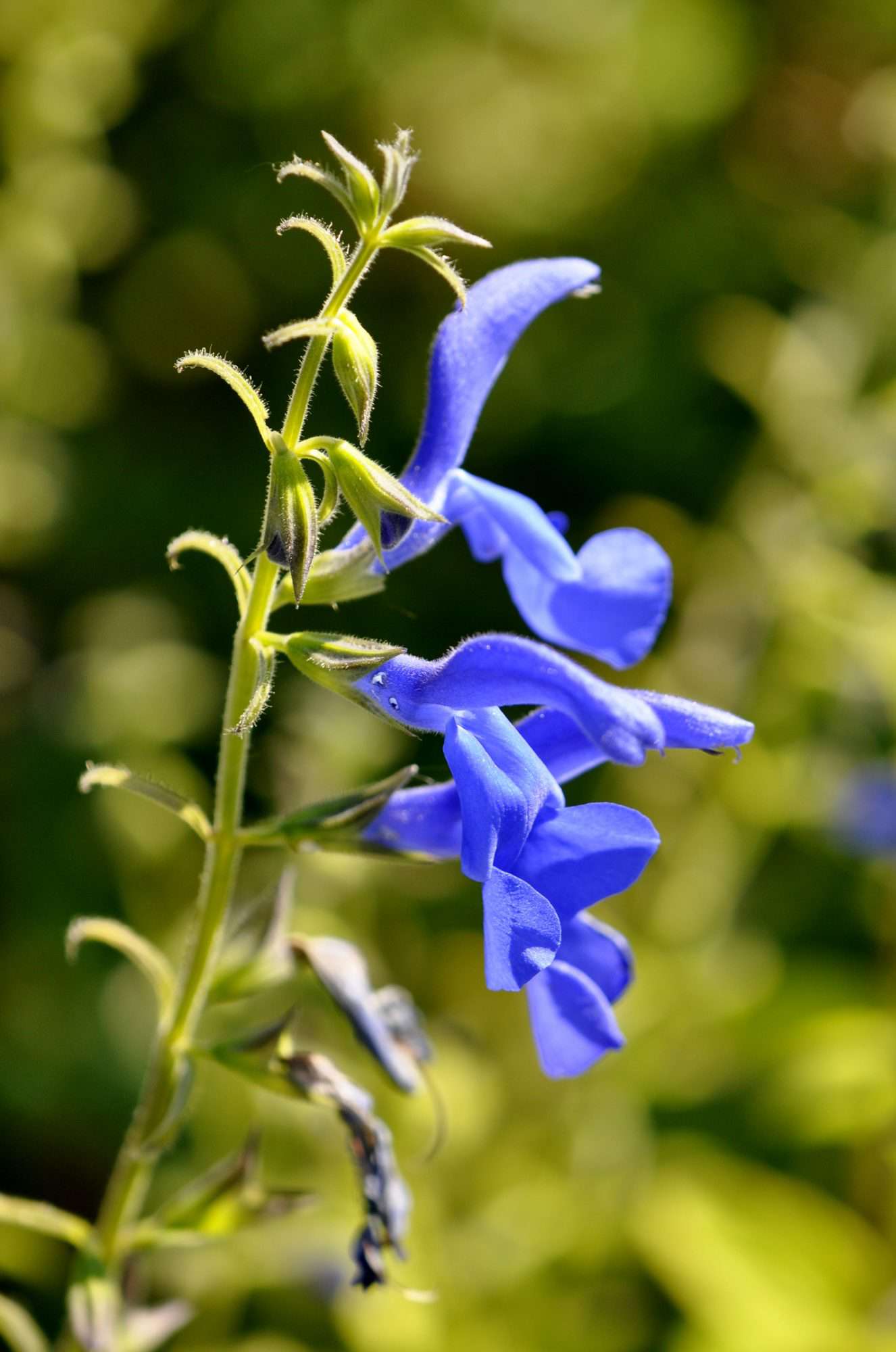
- Botanical Name: Salvia patens
- Sun Exposure: Full sun; some species prefer afternoon shade
- Soil Type: Well-drained
- Soil pH: Acidic to neutral
If you desire a deeper blue plant to complement your garden colors, salvia makes a beautiful choice. Also referred to as sage plants, these aromatic plants are relatively easy to grow in well-drained soil and come in wonderful shades of blue. Most species aren’t appetizing to deer, bunnies, and other critters—so your blooms will be safe and sound. Plant in a sunny spot and water moderately during dry spells.
Sea Holly
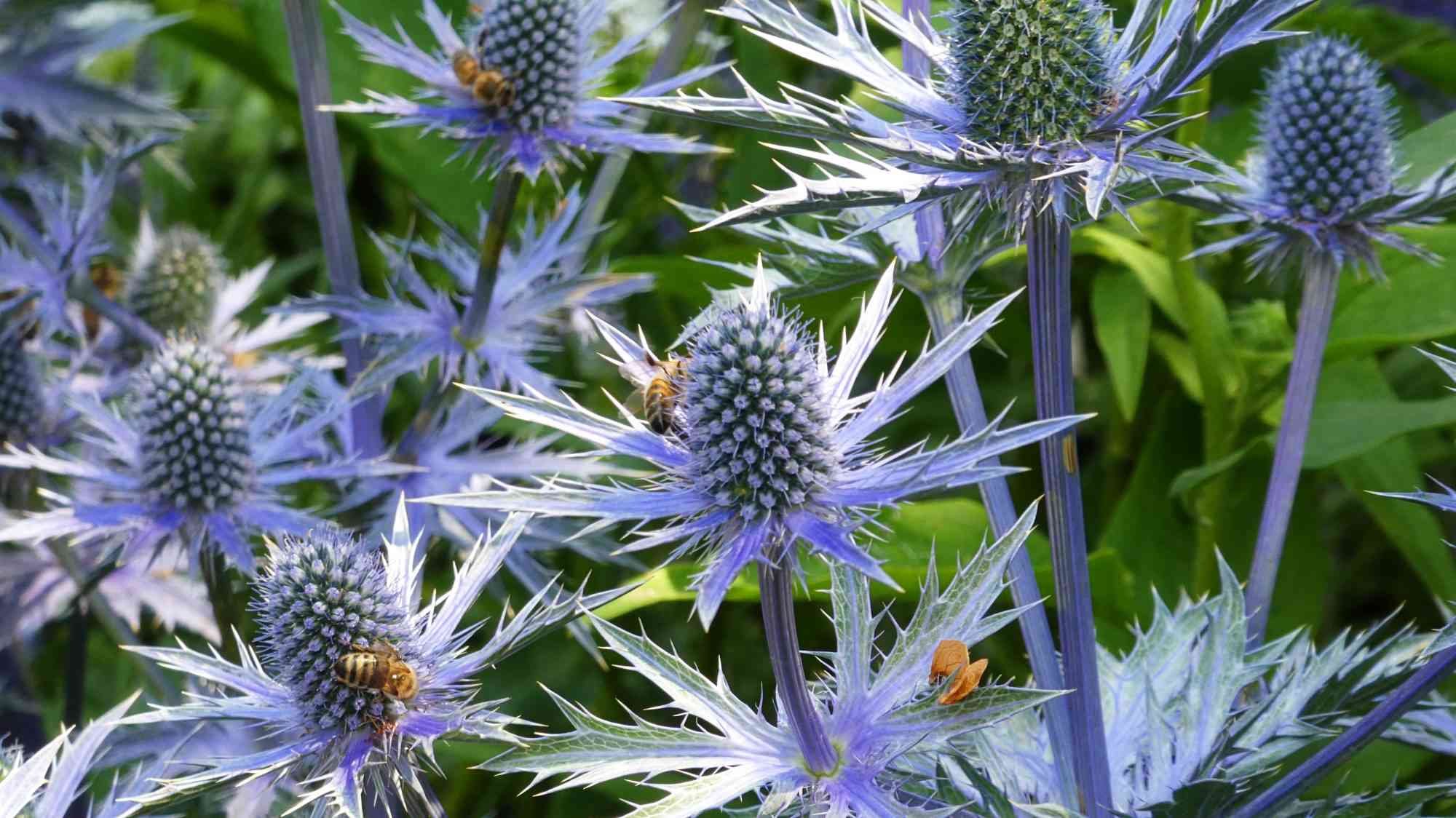
- Botanical Name: Eryngium maritimum
- Sun Exposure: Full sun
- Soil Type: Well-drained, sandy
- Soil pH: Neutral to alkaline
If you live in a climate with sandy or gritty soil that’s inherently low in fertility, this flower is a great choice to get that much-desired pop of blue color during the summertime. Prickly blooms turn into globe-like thistles that look absolutely stunning. Don’t worry about the stench—you can pick the blooms, rinse the scent off them, and use them in arrangements.
Swan River Daisies
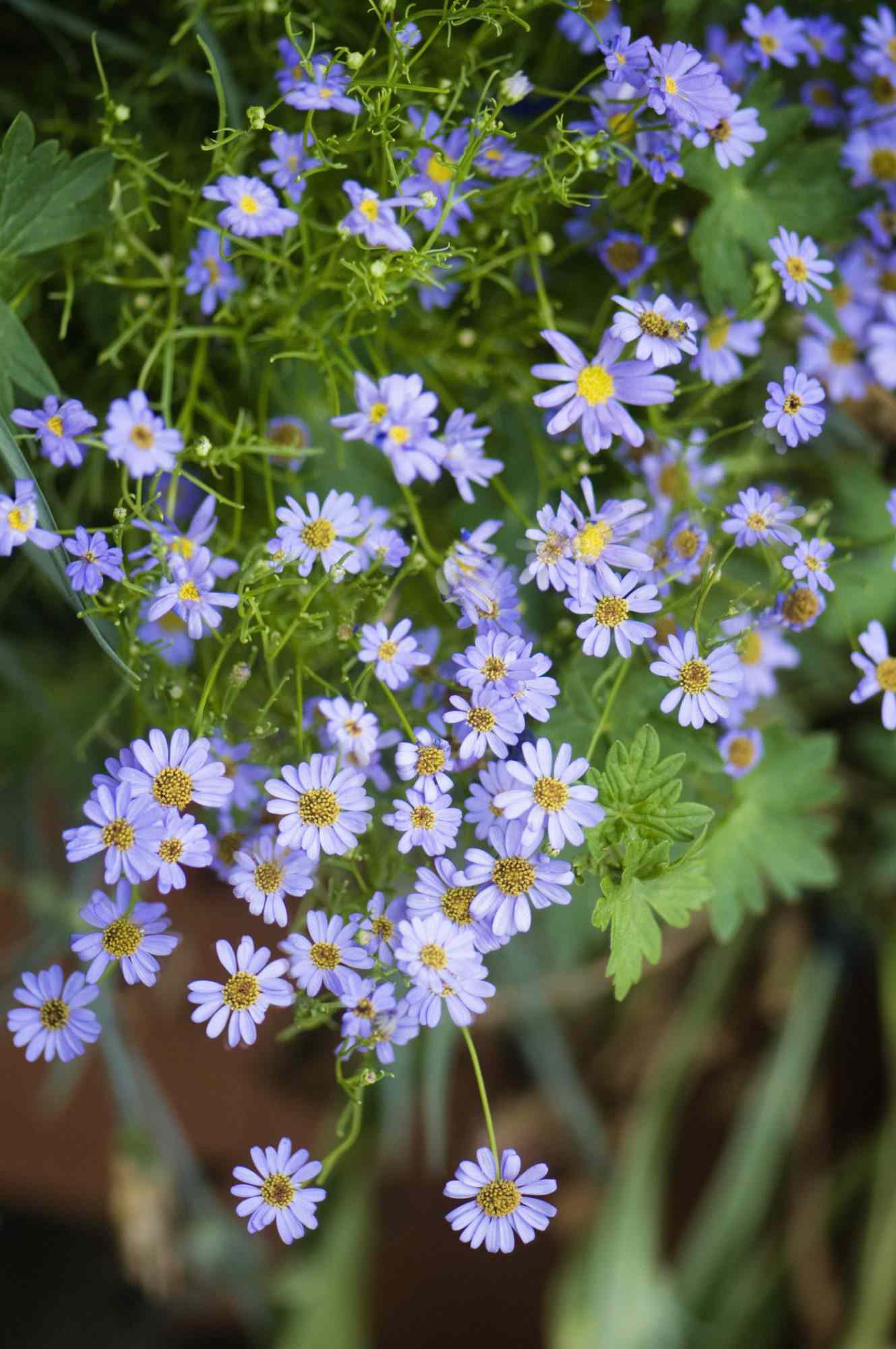
- Botanical Name: Brachyscome iberidifolia
- Sun Exposure: Full sun
- Soil Type: Any well-drained soil, amend with organic matter
- Soil pH: Neutral to alkaline
Look no further than this Australian daisy as a fun pop of color as a filler in your next container or along your outdoor walkway. These flowers are tough little suckers, too. They can handle a variety of soil environments and have decent heat tolerance, though they can struggle in humid climates.
Pansies and Violas
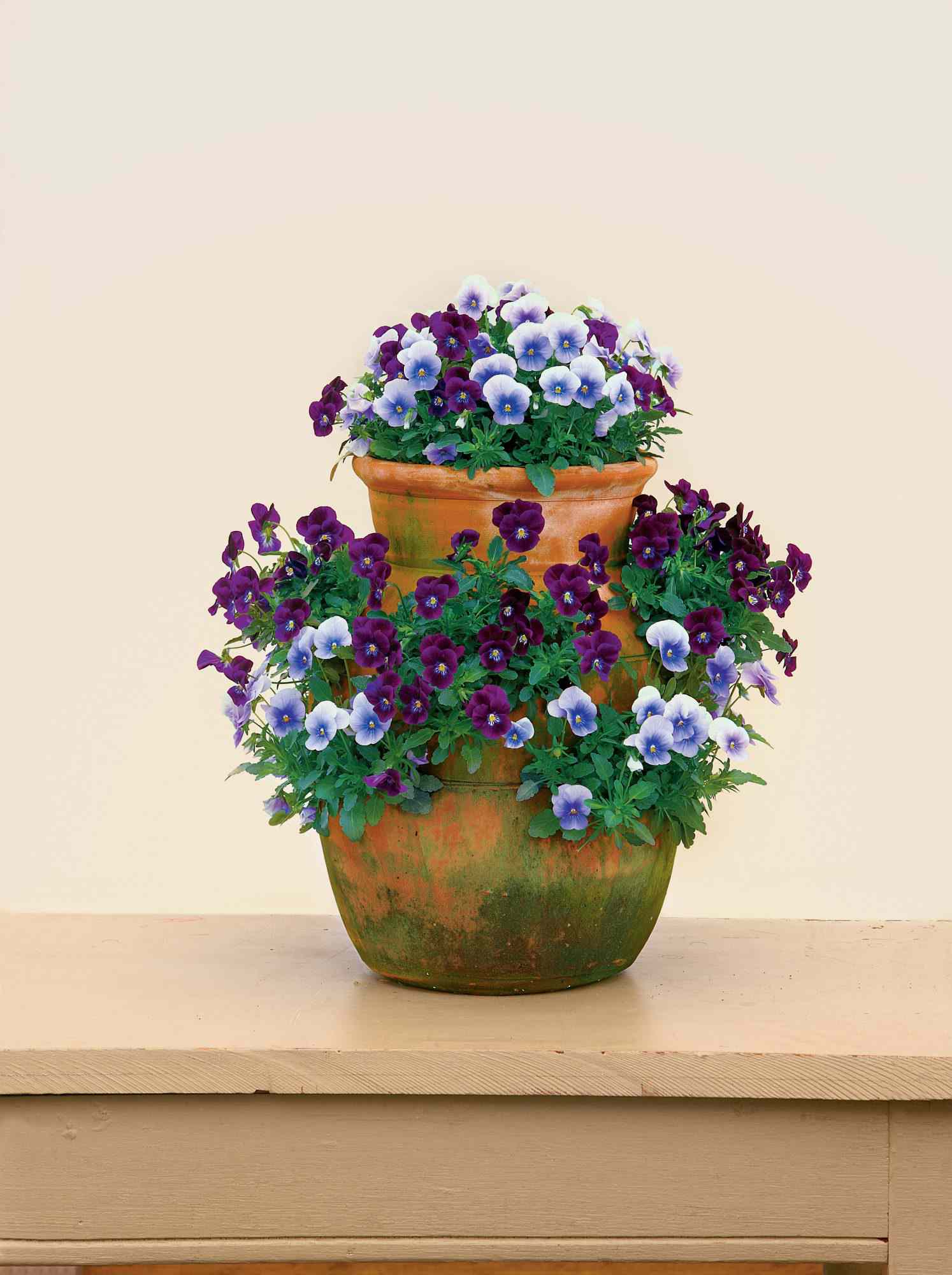
- Botanical Name: Viola spp.
- Sun Exposure: Full sun, part shade
- Soil Type: Well-drained, rich, moist
- Soil pH: Slightly acidic to slightly alkaline
Pansies and violas warm our hearts in the cooler months of the year, and their perky petals can be found in any almost any shade of blue. Use them in the front of the flower bed or in a container, like these «Sorbet Icy Blue» violas. Water regularly and protect them from afternoon sun when summer heat arrives.
Virginia Bluebells
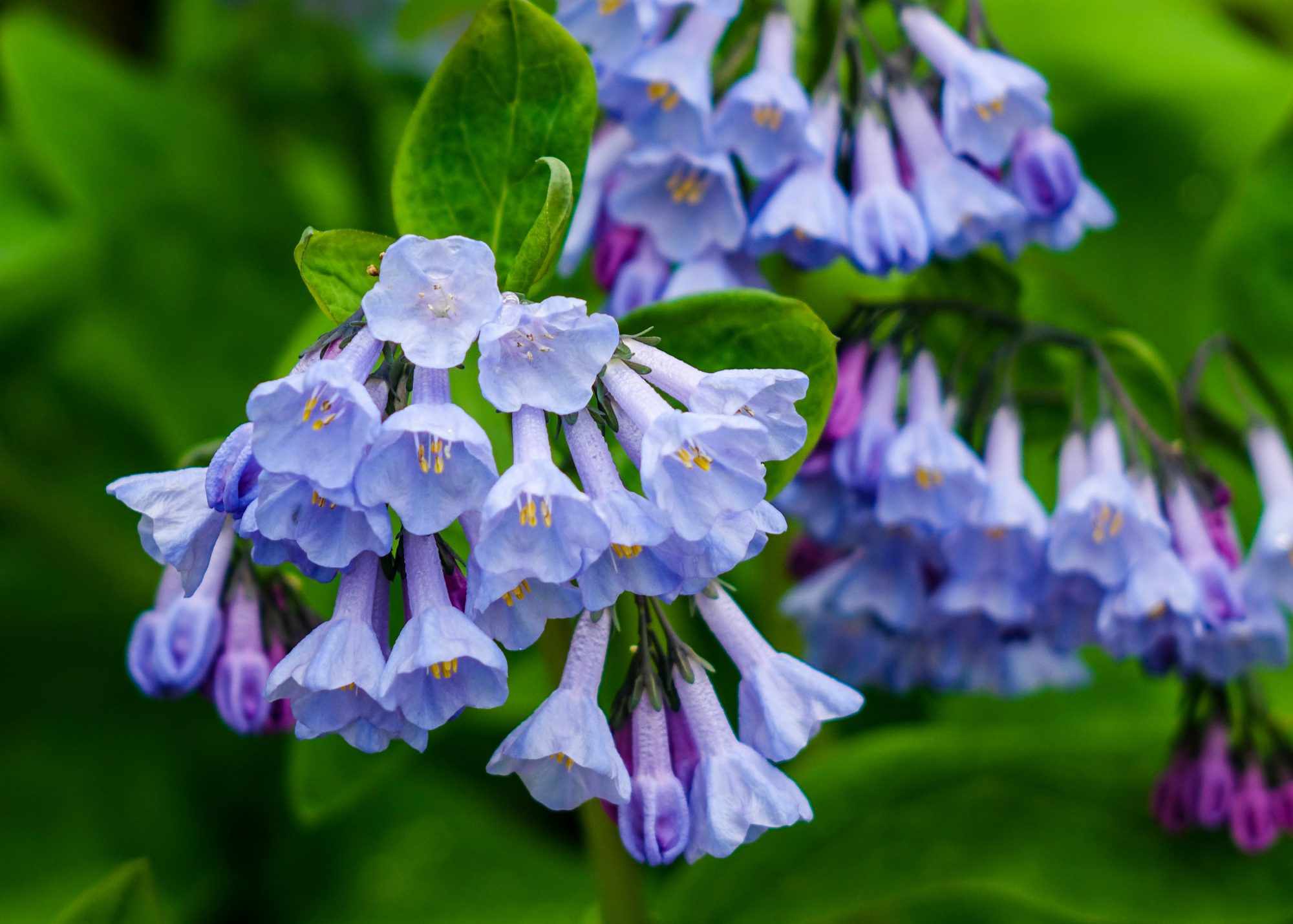
- Botanical Name: Mertensia virginica
- Sun Exposure: Part shade, full shade
- Soil Type: Moist, rich in organic matter
- Soil pH: Neutral
These native woodland flowers produce clusters of nodding baby blue flowers on 1-to-2-foot stems. Virginia bluebells flower early and attract scores of bees and butterflies, which is always a welcome sight come springtime. Pair with other bulbs, ferns, and late-summer blooms to fill the void while bluebells go dormant for summer.